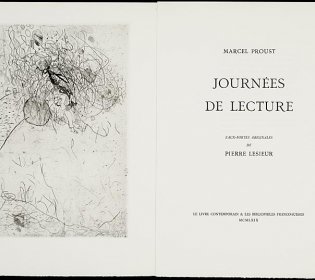Journées de lecture
Year: 1969
Author: Marcel Proust (1871 - 1922)
Artist: Pierre Lesieur (1922 - 2011)
Publisher: Le livre contemporain, Les bibliophiles franco-suisses
Witty metaphors
Proust published the introduction to the translation of Sesame and Lilies under the title Sur la lecture in 1905 in the magazine La Renaissance. The book was to be published a year later by Mercure de France. He published Sur la lecture in 1919 with a few minor changes in his collection Pastiches et mélanges, but under a different title: Journées de lecture. This text was published in 1969 in a bibliophile edition by Le livre contemporain and theBibliophiles Franco-Suisses.
'There might not be any days in our childhood that we experience as intensely as those of which we thought that we didn't really experience them: the days we spent reading a book of our own choice.' These words form the beginning of Journées de lecture. In long, dizzying sentences full of witty metaphors Proust describes in great detail the atmosphere in which he surrendered to the joy of reading as a child. For according to him, what we remember most from what we read is 'the image of the places and days on which we read'.
Sesame and Lilies consists of two speeches Ruskin held in Manchester in 1864: Of king's treasuries and Of queen's gardens. The first speech, Of king's treasuries, is mostly about the importance of books, and was the reason for Proust's article. He didn't fully agree with Ruskin: Proust saw reading as a means, while Ruskin saw it as an end unto itself. Ruskin compared reading to having a good discussion with sophisticated people of previous generations. To Proust, reading gives one magical access to chambers of the soul that had been closed before; it formed a critical mind and made the reader aware of his own inner life. According to Proust, reading becomes dangerous when it doesn't make the reader aware of his own inner life - but instead takes the place of that life. For - he says - finding truth is an ideal that can never be achieved by the passive reading of other people's books.
Subtle artist
The delicately detailed etchings that illustrate Journées de lecture were produced by Pierre Lesieur. Having spent three days at the École des Beaux-Arts and a short period at the academy of cubist painter André Lhote and that of fauvist Othon Friesz, he turned his back on art education. Lesieur developed into a subtle artist on his own, finding inspiration in travel but also in everyday events. In Journées de lecture, books, bookcases, people reading and various details are pictured: an open window, crockery on a coffee table, the chest of drawers in the bedroom with the clock under a glass dome, 'chatting confidentially with seashells from far away and an old, sentimental flower'.
In Journées de lecture, Proust also dedicated a few pages to the Netherlands concerninga traveller in search of the 'truth' hehopes to find in the Netherlands after a fatiguing trip. For there - in Dordrecht, Utrecht of Amersfoort - he may find the truth, for instance 'on the pages of a folio, anxiously guarded in a Dutch convent'. Lesieur's etchings - with the houses reflected in the canals - correspond beautifully with the text.Anna de Noailles was delighted with Proust's introduction to Sesame and Lilies, writing him that all her acquaintances were enchanted by his 'divine pages'. She compared his sentences to precious silken threads. But Proust- accustomed as he was to writing flattering words that weren't wholly sincere- replied to her that his article was 'exécrable', and that these beautiful silken threads stuck to his teeth like nougat.
Bibliographical description
Description: Journées de lecture / Marcel Proust ; eaux-fortes orig. de Pierre Lesieur. - [Paris] : Le livre contemporain : Les bibliophiles franco-suisses, 1969. - [82] p. : ill. ; 38 cm
Printer: Marthe Fequet et Pierre Baudier (text) Lacourière en Frélaut (etchings)
Edition: 200 copies
This copy: Number 136 of 180 on grand vélin de Rives, printed for René Marsal
Typeface: Elzévir ancien
Bibliography: Bénézit 8-568 ; Monod-9327
Shelfmark: KW Koopm K 327
References
- William C. Carter, Marcel Proust:A life. New Haven, CT, Yale University Press, 2000
- Alain De Botton, Hoe Proust je leven kan veranderen. Amsterdam, Atlas, 2001
- Lydia Harambourg, L' École de Paris, 1945-1965: Dictionnaire des peintres. Neuchâtel, Ides & Calendes, 1993
- Marcel Proust, Journées de lecture. Paris, Union générale d'Éditions, 1993
- Jean-Yves Tadié, Marcel Proust: Biographie. Paris, Gallimard, 1996

![Tekst en illustratie pagina[9]](/sites/default/files/styles/galerie/public/images/journees-de-lecture-p9.jpg?h=26a835bf&itok=5qOd7OBB)
![Ets door Pierre Lesieur (p. [11])](/sites/default/files/styles/galerie/public/images/journees-de-lecture-p11.jpg?h=cad2ca3e&itok=xnkVmq8U)
![Ets door Pierre Lesieur (p. [29])](/sites/default/files/styles/galerie/public/images/journees-de-lecture-p29.jpg?h=5bbac387&itok=ZCt0Mzwp)
